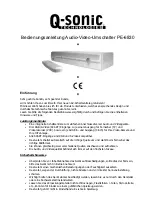
Global functions
10
8. ST B [L/R]
Output of STEREO B channel [L/R]
9. ST A [L/R] INS
Insert Out of STEREO A channel [L/R]
10. ST B [L/R] INS
Insert Out of STEREO B channel [L/R]
Hint
If a signal route 1–6 is selected, you can choose L/R
independently. (But not if the corresponding channel
is paired.)
If both L/R are “OFF” (i.e., when no signal route has
been assigned), selecting one of a pair of channels or
one side of the STEREO A/B channel will cause both
channels to automatically be assigned to L/R.
3
Effect
The currently selected effect is shown by name and
by graphic.
It is not possible to switch the type of effect in this
screen. If you wish to use a different effect, use the
effect library to recall a program that contains the
desired effect.
Hint
If a signal route is assigned only to the input channel
of one side of the effect, the effect will be processed as
mono-in/stereo-out.
If signal routes are assigned to both input channels,
the processing will depend on the effect type. “STE-
REO” types independently process the input signals
from the L/R channels. “MIX” types mix the L/R
channel signals before processing them, and output
the result in stereo. For details on the type to which
each effect belongs, refer to “CS1D Reference Manual
(Appendices).”
•
When the signal path is assigned to only one
input channel
•
When the signal path is assigned to both input
channels
STEREO type effects
MIX type effects
4
TYPE
This knob selects the type of effect.
The types available for selection will depend on the
effect that is displayed in
3
.
5
BYPASS
This button temporarily bypasses the effect.
While this button is turned on, only the original
(“dry”) sound will be output.
6
CUE
This button monitors the effect output. CUE will be
defeated when you switch screens.
7
EFFECT LIBRARY
This button accesses the EFFECT LIBRARY popup
window, in which you can store/recall parameters as
effect programs (
8
OUTPUT L/R
These buttons select the signal route that will be
patched to the L/R output channels of the internal
effect.
When you channel these buttons, a popup window
will appear, in which you can select the signal.
The following signal routes can be selected.
•
CH1–CH96 {CH1–CH48}
Input of input channels 1–96 {1–48}
•
CH1 INS–CH96 INS {CH1 INS–CH48 INS}
Insert In of input channels 1–96 {1–48}
•
ST1–ST8 {ST1–ST4} [L/R]
Input of ST IN channels 1–8 ({1–4}.
•
ST1 INS–ST8 INS {ST1 INS–ST4 INS} (L/R)
Insert In of ST IN channels 1–8 {1–4} (L/R)
•
MIX 1 INS–MIX 48 INS
Insert In of MIX channels 1–48
•
MTRX 1 INS – MTRX 24 INS
Insert In of MATRIX channels 1–24
•
ST A [L/R] INS
Insert In of STEREO A channel (L/R)
•
ST B [L/R] INS
Insert In of STEREO B channel (L/R)
INPUT L
R
L RETURN
EFFECT
R RETURN
INPUT L or R
L RETURN
INPUT L
EFFECT L
R RETURN
INPUT R
EFFECT R
L RETURN
INPUT L
EFFECT
R RETURN
INPUT R
9
5
6
8
7
4
Содержание CS1D
Страница 1: ...Owner s Manual ...
Страница 5: ...Operating Manual ...
Страница 6: ...Operating Manual Start up ...
Страница 55: ...Operating Manual Basic Operation ...
Страница 214: ...Reference Manual ...
Страница 215: ...Reference Manual Hardware ...
Страница 332: ...Reference Manual Software ...
Страница 530: ...Reference Manual Appendices ...
















































